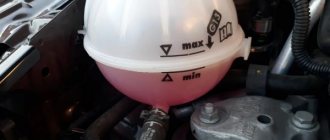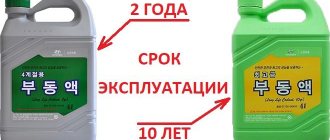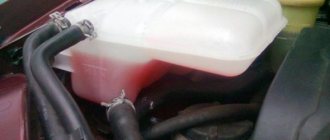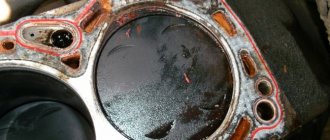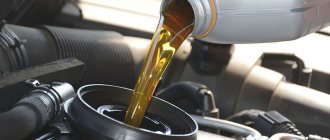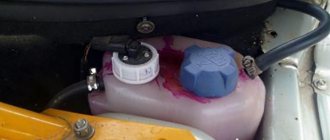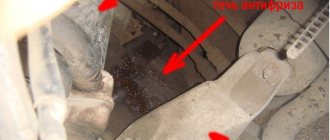Many drivers face such a problem as a refrigerant leak. This thing is not only expensive, but also dangerous for the engine. Therefore, if you notice that the liquid level in the tank is rapidly decreasing, that is, antifreeze is leaving, it is necessary to urgently take appropriate measures. What could be the reasons for this phenomenon and how to correct the situation, we will consider in this article.
Preventing engine breakdown
In order to avoid engine breakdown due to loss of coolant, it is necessary to periodically check all system components for potential leaks. Of course, you should definitely monitor the refrigerant level in the tank. When the engine is running, it should never be below the MIN mark. Signs that antifreeze is running out may include the following factors:
- The stove doesn't work.
- The fluid level in the reservoir periodically drops.
- The engine overheats or its temperature does not rise to operating temperature.
A slight decrease or increase in the antifreeze level when heating or cooling the engine is quite normal. If antifreeze has to be added periodically, it means that you urgently need to look for the cause of the malfunction.
Where does antifreeze go from the expansion tank?
It is impossible to give a definite answer to the question. There are pitfalls and currents regarding the operating features of the car. It is necessary to establish the causes of the antifreeze leak and then take corrective action.
It is not necessary to constantly monitor the level of antifreeze in the expansion tank. Special sensors monitor the liquid level in real time. When the level drops, the machine’s computer system will issue an information message in the form of a glowing icon on the instrument panel.
It is recommended to update antifreeze at least once every 2 years. If the coolant level warning system frequently triggers, you need to look for leaks. Even after using the car for a long time, antifreeze only needs to be added in very small quantities.
Reasons for a decrease in the level of antifreeze in the expansion tank:
Loose expansion tank cap
A common cause of coolant leaks. Occurs due to the carelessness and carelessness of the driver. A loose expansion tank cap does not hold back the pressure of the incoming coolant. Antifreeze oozes through a loose connection.
Coolant actively decreases during engine operation. In winter, the leakage of antifreeze through the expansion tank cap can be noticed by the appearance of white smoke in the area of the radiator grille.
The evaporating antifreeze turns into a whitish haze. To eliminate the malfunction, the lid is tightly clamped.
Damage to the expansion tank
Often, “would-be masters” or the drivers themselves damage the tank when handling the tool carelessly during repair work. If the damage is above the antifreeze level, it will be difficult to notice.
Problems begin later, when the car begins to be actively used. The fluid level increases and antifreeze flows out through the damage. The level drops and you have to top it up to the recommended level.
A visual inspection with the engine running and warm quickly reveals the location of the leak. The tank is being replaced since it cannot be repaired. After repair, after a certain period of time, the problem makes itself felt again.
Damage to hoses, tubes and their connections to the radiator
Hoses and tubes of the engine cooling system are exposed to aggressive environments. Temperature changes, oils, brake fluid and other chemicals.
When it gets on the rubber elements of hoses and tubes, it causes damage after some time. Invisible at first glance, and visually difficult to find at the initial stage.
Antifreeze begins to leak through damaged hoses and tubes. Every day the size of losses increases. After a while, the driver will be surprised to find that it is necessary to add coolant again.
To eliminate the malfunction, replace damaged hoses and tubes. It won't take much time and can be done without outside help.
Excessive amount of antifreeze
The expansion tank has a mark on its surface where antifreeze must be poured. Makes up exactly half of the total capacity of the tank.
Made specifically to prevent coolant from overflowing and creating excess pressure. Increasing antifreeze pressure leads to damage to the tank. It will burst and require replacement.
Manufacturers have provided a special overflow hole. When the amount of antifreeze in the tank becomes critically large, it begins to flow out through the overflow hole. To prevent such cases, fill in antifreeze to the mark.
Radiator damage
The radiator is located at the front of the car and is used to cool the antifreeze circulating in the engine cooling system. While the car is moving, the radiator absorbs small stones, dust and small particles of dirt with oncoming air flows.
Frequently flying stones and small gravel can damage the surface of the radiator and compromise its integrity. Antifreeze begins to leak out through the damage. The level can drop quickly and it all depends on the degree and size of the damage.
Engine
One of the most unpleasant types of antifreeze leakage is its appearance in the engine combustion chamber. Identified by white smoke coming from the exhaust pipe. A sweetish smell appears in the air around the exhaust pipe. This is the first sign of antifreeze combustion along with fuel.
Another sign of antifreeze getting into the engine is the appearance of a white coating on the oil dipstick. Carrying out car repairs on your own is problematic without the use of special equipment.
To quickly detect the loss of antifreeze from the tank, you need to look under the hood of the car more often. This will help you quickly respond to faults and carry out repair work with minimal material costs. A deficiency of antifreeze has a negative effect on engine cooling.
Checking the integrity of cooling system components
In the event of a leak, the system must be inspected in the following sequence:
- Check the expansion tank housing for cracks.
- Inspect the engine radiator.
- Check the heater core.
- Inspect the thermostat housing.
- Check all connections of the pump and cylinder block. In addition, you should inspect the pump drain hole. If leakage is detected, this means that the oil seal has worn out.
Possible problems with the radiator
The reason that antifreeze leaves the expansion tank is the depressurization of the cooling system components. Most often, problems arise with the radiator. Damage to this structural element can occur as a result of external physical impact (for example, when punctured by a stone). The plates, which are constantly damaged by the ethylene glycol contained in antifreeze, may also be worn out. Some radiators may be equipped with plastic tanks. The latter should also be checked in case of loss of antifreeze. Over time, the plastic begins to crack.
Why is antifreeze used in a car?
During operation, any motor experiences serious loads and its temperature rises significantly. The heat obtained as a result of combustion is partially transferred to the engine.
To avoid overheating of the power plant and its failure, experts suggested using antifreeze. It did not appear immediately; initially, ordinary distilled water and antifreeze were used in older car models.
Antifreeze is used on all new cars. Proven effectiveness during use. Does not freeze at low temperatures, protects individual engine elements from corrosion processes and removes excess heat from the engine.
Antifreeze is a mixture of purified water, ethylene glycol and glycerin. To enhance the properties and extend the service life, manufacturers use branded additives. Prevents foam formation, protects against corrosion and increases resistance to temperature changes.
There are antifreezes on sale that differ in color. This feature is misleading for inexperienced drivers. Many people are sure that only one color is suitable for a certain brand of car. There is actually no difference in the color of the antifreeze. You can fill in any one and move on calmly.
You need to pay attention to the color of the antifreeze in the expansion tank. If it's red, it's better to use red. Mixing antifreeze of different colors is not recommended. This impairs performance and leads to the appearance of sediment.
Damage to the heater core
You should also find out where the antifreeze goes. If there is an unpleasant odor in the cabin, and a sticky stain is constantly spreading under the dashboard, then the cause of the leak is most likely in the heating radiator. In this case, white steam also usually enters the cabin. Elimination of such a problem must begin immediately. The fact is that antifreeze vapors are toxic.
Checking the Thermostat
If the antifreeze leaves, the reasons may be a depressurization of the thermostat. It also needs to be carefully checked for leaks. Usually the reason is the gaskets. In addition, the engine may overheat due to a malfunction of this element. It is not difficult to determine how correctly a given node works.
The circulation of liquid in the small and large circles is checked by touch - by the temperature of the hose and pipes. In a working cooling system, the thermostat valve is closed until the antifreeze temperature reaches a certain value (in LADA Priora - up to 90 degrees). In this case, antifreeze circulates in a small circle. Therefore, both the radiator itself and the hose below are colder than the thermostat housing. When the antifreeze heats up to 90 degrees, the valve begins to open slowly, and a flow of hot liquid enters the radiator. As a result, the latter gradually heats up. The valve will open completely at a temperature of 102°C. In this case, all the antifreeze will begin to pass through the radiator. The upper part will feel hotter than the lower part.
The engine must be left running until the radiator fan operates. In this case, it is necessary to monitor the arrow of the temperature indicator. After it approaches the border of the red zone, the fan should turn on. When the liquid cools down, it turns off.
How to fix a coolant leak
It is quite difficult to restore the tightness of the cooling system on your own. First, you need to find out where the antifreeze was flowing, by the characteristic traces left by the coolant. Work such as replacing a radiator, pipes, pumps should be carried out in a car repair shop, since they require certain skills from the car mechanic and the presence of special equipment.
If the leak is small, then you can use a temporary measure that consists of purchasing and adding automotive sealant to the antifreeze. However, it is worth knowing that the sealant not only covers damage that has occurred in the system - its use negatively affects the further operation of the radiator and car pump. It can clog most of the tubes in the radiator, making it impossible to effectively cool the antifreeze, which will lead to engine overheating. If the sealant gets on the pump impeller, it can also damage it, so it can only be used in extreme cases.
Thanks to the Uremont.com service, you can quickly find a company that provides high-quality repairs and maintenance of the engine cooling system at an affordable cost. With us, any type of work is prompt, high-quality and at a low cost.
Hose rupture and pipe damage
Antifreeze can also leak through a damaged hose or through a depressurized pipe. This is especially often the reason why antifreeze runs out in older cars. The fact is that the hose material begins to age and crack over time. It can easily burst due to liquid pressure. The fastening at the connection also weakens over time. Therefore, in order to avoid troubles, hoses in domestic cars should be changed at least once every 5 years, and in foreign cars - once every 10 years. For fastening, you should use screw clamps rather than tape clamps, since they are much more reliable.
You can determine that the hoses are to blame for the leak by inspecting the floor for antifreeze stains. Sometimes the damage may not be too serious and invisible to the eye. In order to detect such a small leak, you must first thoroughly wipe the hose, and then rev it up a little and turn off the engine. Next, a careful inspection is carried out. The problem of coolant loss can worsen during the cold season. The fact is that the lower the temperature, the lower its viscosity. That's why antifreeze disappears faster in winter.
Let's sum it up
If the driver determines that the car has an antifreeze leak, but cannot independently determine what caused it and/or fix the problem, you should visit a service center. Specialists carry out diagnostics and carefully check the entire cooling system for correct operation. After determining the cause of the malfunction, it is eliminated: the part or assembly is repaired or replaced. To make it easier to solve problems associated with antifreeze leaks, it is recommended:
- use coolants with the addition of fluorescent pigments. The latter are sold separately and can be added to a tank with already filled coolant;
- Do not add water to antifreeze in winter. This leads to a decrease in the concentration of the main substance and freezing of the coolant in the channels of the cooling system, which entails significant problems in the operation of the car.
#Trouble-shooting
Replacing pipes
This operation can only be performed after the engine has completely cooled. Otherwise, it is easy to get a steam burn. Replacing the pipe is done as follows:
Liquid is drained from the cooling system. In this case, it is best to take clean dishes. Antifreeze can be used repeatedly.- Old clamps are coated with a small amount of oil (low viscosity).
- In order to disconnect the pipe, the clamps should be loosened and moved lengthwise to a free space.
- After this, the pipe is removed from the neck. A hot system cannot be disconnected. Since radiator necks are not particularly durable, all operations must be performed as carefully as possible. Sometimes it happens that the pipe cannot be removed. In this case, you should first try to turn it on. If this does not help, you will have to cut it with a sharp knife along the neck. In any case, it costs less than a radiator.
- Place clamps on the new pipe and move them to the middle.
- Next, it is pulled over the neck. If the pipe does not fit, it must be immersed in hot water for a while. It is not recommended to use any oils. The fact is that they can damage the rubber.
- The pipe is pulled completely onto the neck, making sure that it does not twist.
- The clamps are moved by the protrusions and tightened.
How to properly drain antifreeze
Of course, before you start replacing the cooling system elements that have become unusable, you need to drain the antifreeze. They do this as follows:
- First of all, be sure to turn off the engine and let it cool. If this is not done, when you open the lid, antifreeze vapor will escape under pressure and you will get burned.
- After the engine has cooled, open the locking cap of the tank.
- Remove the lower lining of the compartment.
- You will need to place a wide tray under the engine to receive antifreeze.
- Remove the lower water radiator hose.
In a four-cylinder engine, you need to remove the thick hose on the left side, as well as the thin one leading to the heating system. After this you can start draining. In a six-cylinder engine, the screw plug is unscrewed from the bottom of the block.
Under no circumstances should antifreeze be poured down the drain. The liquid is very toxic. Therefore, it should be poured into a separate container and disposed of.
Thus, if antifreeze is lost, it is necessary to thoroughly check all components and parts of the cooling system for leaks. Elements that have become unusable should be replaced immediately. Over time, such problems can lead to the need for expensive engine repairs, and in some cases they can even be dangerous to health.
